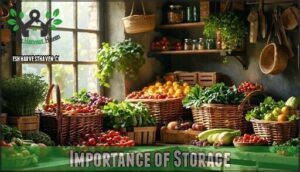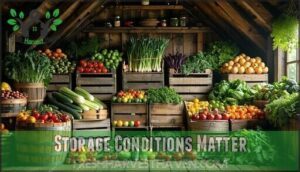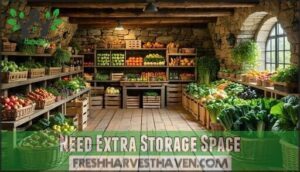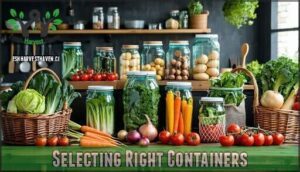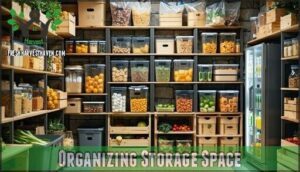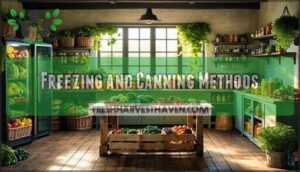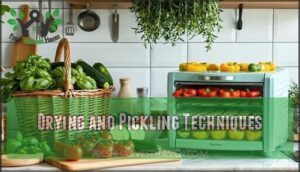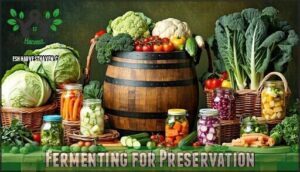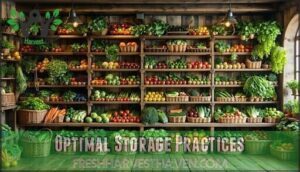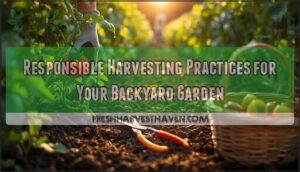This site is supported by our readers. We may earn a commission, at no cost to you, if you purchase through links.
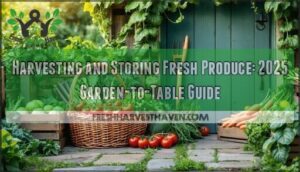 Timing’s everything when harvesting and storing fresh produce.
Timing’s everything when harvesting and storing fresh produce.
Pick vegetables like tomatoes when they’re fully colored but still firm, and leafy greens in cool morning hours.
Harvest herbs before they flower for peak flavor.
Storage conditions make or break freshness – some crops need cool, dry spaces while others prefer cold, humid environments.
Root vegetables store best in dark, ventilated areas, while fruits like apples need consistent cool temperatures.
Clean produce gently, remove damaged pieces, and use proper containers with adequate airflow.
Temperature and humidity control are your best friends for extending shelf life.
Smart storage techniques can double or triple your harvest’s lifespan by using the right methods to keep your produce fresh for a longer period, which is the key to enjoying your harvest for an extended time with proper containers.
Table Of Contents
- Key Takeaways
- Harvesting Fresh Produce
- Importance of Storage
- Storage Conditions Matter
- Choosing Storage Containers
- Preserving Fresh Produce
- Optimal Storage Practices
- Frequently Asked Questions (FAQs)
- How to keep vegetables fresh after harvesting?
- What is the best way to store fresh produce?
- How long can fresh produce be stored?
- Do not wash fresh produce before storing.?
- How do you prevent cross-contamination between vegetables?
- What tools are essential for proper harvesting?
- Can overripe produce affect nearby vegetables?
- How do you know if storage containers need replacing?
- What are signs of pest damage during storage?
- Conclusion
Key Takeaways
- Time your harvest right – Pick tomatoes when they’re fully colored but firm, harvest leafy greens during cool morning hours, and collect herbs before they flower for peak flavor.
- Match storage to produce needs – Store root vegetables in cool, dry, dark spaces at 50-60°F, keep leafy greens cold and moist at 32-40°F with 95% humidity, and maintain tomatoes at room temperature.
- Control temperature and humidity strictly – Monitor storage conditions daily since fluctuations can cut shelf life in half, and use proper ventilation to prevent moisture buildup that leads to rot.
- Use first-in-first-out rotation – Label everything with harvest dates, arrange newer items behind older stock, and inspect stored produce weekly to remove any showing decay before it spreads.
Harvesting Fresh Produce
Knowing when and how to harvest your garden produce makes the difference between bland, tough vegetables and peak-flavor treasures that’ll have your neighbors asking for your secrets.
The right timing transforms your hard work into a bounty that tastes incredible and stores longer than you’d expect, yielding incredible results from your garden.
General Harvesting Tips
Why settle for mediocre produce when superior harvesting transforms your garden’s potential?
Handle vegetables gently to prevent bruising and disease spread. Use sharp, clean harvest tools for precise cuts that encourage continued production.
Sharp tools and gentle hands separate master gardeners from weekend warriors—handle your harvest like the treasure it is.
Check crops daily during peak season – timing separates amateur gardeners from pros. Harvest only premium-quality produce, as damaged vegetables spoil quickly and contaminate storage areas.
Understanding key harvest fresh techniques is vital for maximizing yields and quality. These harvesting techniques form your foundation for successful harvesting and storing, leading to successful harvesting.
When to Harvest Common Vegetables
Beyond checking the calendar, successful vegetable timing relies on recognizing visual harvest signs that signal peak ripeness.
Each crop displays unique indicators when ideal harvesting techniques should begin.
Here are three key ripening stages to master:
- Tomatoes – Harvest at breaker stage when 50% pink, allowing continued ripening off-vine while avoiding fruit splitting
- Carrots – Look for visible shoulders above soil at 3/4-inch diameter, typically 60-80 days after sowing
- Beans – Pick snap varieties when pencil-thick, 2-3 weeks post-bloom, before seeds fully develop inside pods
Understanding the vegetable harvest guide is vital for maximizing yields and flavor.
When to Harvest Common Fruits
Understanding fruit ripening signals guarantees you’ll capture peak flavors and nutrition.
Unlike vegetables that can surprise you overnight, fruits often telegraph their readiness through color changes, aroma, and gentle give when pressed.
| Fruit | Harvest Indicators | Storage Life |
|---|---|---|
| Apples | Firm, full color, easy stem detachment | 2-6 months cold/dry |
| Strawberries | Fully red, fragrant, caps detach easily | 3-7 days refrigerated |
| Tomatoes | Pink to red color, slight softness | 5-7 days at 55°F |
| Citrus | Heavy feel, bright color, glossy skin | 2-8 weeks cool/dry |
| Berries | Deep color, sweet aroma, release easily | 3-10 days refrigerated |
The "twist test" works perfectly for apple picking—ripe fruit separates cleanly from branches with a gentle upward twist.
Berry picking requires a delicate touch; overripe berries collapse under pressure while underripe ones cling stubbornly to stems.
When to Harvest Common Herbs
Harvest herbs when they’re at peak flavor, typically in early morning after dew dries but before heat intensifies.
For leafy greens like basil, pinch fresh cuttings just above leaf nodes to encourage new growth.
Most culinary herbs reach prime herb quality before flowering – that’s when essential oils concentrate for maximum taste.
Regular harvest schedules promote continuous production throughout your growing season, making your garden harvest guide more rewarding.
Importance of Storage
You can’t enjoy the rewards of a successful harvest without proper storage techniques that preserve freshness and extend shelf life.
Smart storage decisions transform your garden bounty from a fleeting moment into months of nutritious meals for your family, utilizing proper storage techniques to maintain the quality of your harvest.
Benefits of Proper Harvesting and Storage
Proper harvesting and storage dramatically extends your fresh produce’s shelf life while maintaining peak nutrition and flavor.
When you nail harvest timing and create ideal storage conditions, vegetables like carrots can last four months instead of weeks.
Smart storage efficiency prevents food waste, saving you money and trips to the store, and following food safety guidelines during harvest storage protects your family from contamination.
Master these produce preservation techniques, and you’ll enjoy garden-fresh taste year-round while maximizing your investment in homegrown food.
Factors Affecting Shelf-Life
Several key factors determine how long your fresh produce stays fresh.
Temperature control tops the list—dropping storage temperature by just 18°F can double or triple shelf life by slowing metabolic activity.
Humidity levels matter too; leafy greens need high moisture while potatoes prefer dry conditions.
Ethylene production from ripening fruits accelerates spoilage in nearby vegetables.
Handling techniques also play a vital role since even minor bruises create entry points for decay.
Master these storage conditions for maximum freshness.
Proper fruit storage methods can substantially extend the shelf life of fresh produce, and understanding temperature control, humidity levels, and ethylene production is crucial for maintaining maximum freshness.
Storage Conditions Matter
Getting the storage conditions right can make or break your harvest’s longevity.
The wrong environment turns crisp vegetables into compost faster than you’d expect, while proper conditions keep your garden’s bounty fresh for weeks or even months, which is why getting the storage conditions right is crucial for maintaining the longevity of your harvest.
Cool and Dry Storage
When you need maximum shelf life for onions, garlic, and hard squashes, cool and dry storage becomes your go-to method.
Store these crops at 50-60°F with 60% humidity in well-ventilated spaces like basements or root cellars for ideal results.
- Basement storage works perfectly for onions and garlic—just avoid damp corners
- Root cellars provide ideal conditions when properly ventilated and monitored
- Dry containers like cardboard boxes or mesh bags promote airflow around produce
- Humidity control prevents mold while maintaining that sweet spot around 60%
Cold and Moist Storage
Most root vegetables and leafy greens thrive in cold storage with high humidity levels around 95%.
Your refrigerator’s crisper drawer creates these moist environments perfectly for carrots, beets, and lettuce.
Root cellars offer ideal conditions naturally, maintaining temperatures between 32-40°F while preventing produce from drying out.
Proper humidity control extends shelf life substantially compared to dry storage methods.
Effective vegetable storage methods are essential for maintaining the quality of harvested produce, using the right storage methods.
Room Temperature Storage
While cold storage preserves most vegetables, some produce performs better at room temperature.
Certain fruits and herbs maintain peak Fresh Shelf Life when stored in Ambient Conditions rather than chilled environments.
Here are five room temperature storage champions:
- Tomatoes – Counter Storage maintains their flavor and prevents mealy texture
- Basil – Herb Keeping works best in water at room temperature like fresh flowers
- Bananas – Fruit Storage at ambient temperature prevents skin blackening
- Avocados – Ripen perfectly on counters with proper humidity control
- Potatoes – Dark, cool pantries provide ideal storage conditions away from light
These produce handling tips guarantee your fruits and vegetables reach peak ripeness naturally.
Choosing Storage Containers
You’ll need the right containers to keep your harvest fresh longer and maximize your storage space.
The wrong choice can turn your beautiful produce into expensive compost faster than you’d like, which is why choosing the correct containers is crucial.
Need Extra Storage Space
When your harvest exceeds your kitchen’s storage capacity, think beyond traditional spaces.
A basement or root cellar offers natural climate control for long-term storage solutions. Consider investing in breathable storage containers and vertical space optimization through shelf organization systems.
Self-storage units with refrigeration systems provide additional space for preserving large quantities of produce efficiently.
Proper storage techniques involve understanding ideal humidity control methods to maintain freshness and extend shelf life, using breathable storage containers and optimizing storage for long-term preservation.
Selecting Right Containers
Beyond choosing the right location, smart container selection makes all the difference in extending your produce’s shelf life.
Glass, stainless steel, and BPA-free storage containers offer superior safety and durability for your harvest.
Consider these essential container materials for ideal freshness:
- Breathable storage containers with adjustable vents for root vegetables
- Airtight containers made from glass or stainless steel for dried goods
- Mesh bags for onions and potatoes requiring air circulation
- Vacuum-sealed bags for freezer storage and long-term preservation.
Effective labeling systems help track harvest dates and rotation schedules.
When storing produce, using proper storage containers is vital for maintaining freshness and quality.
Organizing Storage Space
Once you’ve selected your storage containers, maximizing your space becomes the next challenge.
Smart shelf management transforms cramped areas into organized systems. You’ll maximize vertical space with stackable containers and wall-mounted racks. Effective labeling systems prevent confusion during busy harvest seasons.
Utilizing stackable container systems can substantially enhance storage efficiency.
| Storage Zone | Best Containers | Organization Tips |
|---|---|---|
| Basement | Wooden crates, ventilated bins | Use vertical storage racks, maintain airflow |
| Root Cellar | Perforated plastic, mesh bags | Create inventory management zones by type |
| Refrigerator | Clear containers, produce bags | Implement drawer dividers for space utilization |
| Pantry | Airtight jars, labeled boxes | Install adjustable shelving for climate control |
Preserving Fresh Produce
When you’ve harvested more produce than you can use fresh, preservation methods extend your garden’s bounty for months ahead.
Freezing, canning, drying, pickling, and fermenting each offer unique advantages for different vegetables and your storage goals.
Freezing and Canning Methods
Two proven methods safeguard your harvest for months ahead. Freezing preserves nutrients while canning creates shelf-stable storage without electricity needs.
Essential Preservation Steps:
- Blanch vegetables before freezing – stops enzyme action that causes flavor loss
- Use proper canning methods – water bath for high-acid foods, pressure canning for vegetables
- Package in freezer-safe containers – prevents freezer burn and maintains quality
- Follow tested recipes exactly – guarantees food safety and maximum results
- Label everything with dates – practice first-in-first-out rotation for best quality
These food preservation methods give you control over your harvest’s future. Proper storage using freezer container options is vital for maintaining the quality of frozen produce.
Drying and Pickling Techniques
Drying removes moisture to prevent spoilage while pickling preserves produce in acidic solutions.
Air-drying works for herbs like basil, while electric dehydrators handle tomatoes and peppers efficiently.
Drying times vary: herbs need 2-4 hours, vegetables require 6-12 hours.
Both dehydration methods and pickling tips extend your harvest’s life substantially beyond traditional canning and freezing approaches.
Fermenting for Preservation
Fermentation transforms your fresh vegetables into probiotic powerhouses while extending shelf life naturally.
Unlike pickling with vinegar, fermentation uses beneficial bacteria to create lactic acid, preserving nutrients while developing complex flavors.
Your homemade sauerkraut contains more probiotics than store-bought versions.
Fermentation Basics for beginners:
- Use salt ratios of 2-3% by weight for proper fermentation
- Keep vegetables submerged under brine to prevent mold growth
- Maintain temperatures between 65-75°F for ideal probiotic development
Food safety requires clean tools and proper salt concentrations.
Fermenting vegetables like cabbage, cucumbers, and carrots creates nutrient-dense foods with probiotic benefits that support digestive health.
Understanding canning recipes is also vital for preserving harvests and extending shelf life.
Optimal Storage Practices
You’ve mastered the art of harvesting and preserving your garden’s bounty, but the real magic happens when you apply ideal storage practices.
These proven techniques will transform your fresh produce from a week’s worth of meals into months of garden-fresh nutrition.
Maintaining Temperature and Humidity
Accurate temperature control and humidity management determine your storage success.
Monitor these conditions daily, as fluctuations can cut shelf life in half.
Most produce thrives at 32°F, but some vegetables demand specific ranges for maximum freshness.
| Storage Type | Temperature | Humidity Level | Best For |
|---|---|---|---|
| Cold & Moist | 32-40°F | 90-95% | Root vegetables, leafy greens |
| Cool & Dry | 50-60°F | 60-70% | Onions, garlic, winter squash |
| Cool & Moist | 55°F | 85-90% | Tomatoes, cucumbers, peppers |
| Room Temperature | 68-72°F | 50-60% | Basil, certain herbs |
Climate monitoring systems help you catch problems before they start.
Simple thermometers and humidity gauges work fine for small-scale storage.
Ventilation methods like fans or vents prevent moisture buildup that leads to rot.
Your cooling systems don’t need to be fancy—even a well-placed fan can make the difference between crisp vegetables and soggy disappointments.
Preventing Spoilage and Disease
Since bacteria thrive on damaged produce, you’ll want to start with clean hands and sanitized tools before handling any harvest.
Regular sanitation methods like washing storage containers with bleach solutions can reduce microbial loads by up to 100-fold.
Implement crop rotation in your garden to break disease cycles, and maintain proper storage conditions with temperature control around 32°F and humidity management specific to each vegetable type.
Inspect stored produce weekly, removing any items showing signs of decay to prevent mold prevention failures that spread to healthy items, ensuring proper storage conditions are maintained.
Implementing First-In-First-Out Rotation
First-in-first-out rotation prevents produce from becoming forgotten casualties in storage containers.
Label everything with harvest dates and arrange items so you’ll naturally reach for older produce first.
Your storage system should make FIFO rotation effortless—place newer harvests behind existing stock.
This inventory management approach maximizes shelf life and minimizes waste throughout your harvest storage period.
Frequently Asked Questions (FAQs)
How to keep vegetables fresh after harvesting?
Cool collection and careful cleaning keep vegetables vibrant after harvest. Handle minimally, store at proper temperature (32°F ideal), maintain appropriate humidity, and provide ventilation to maximize freshness and shelf life.
What is the best way to store fresh produce?
Store produce by matching temperature and humidity needs.
Keep root vegetables cold and moist (32-40°F, 95% humidity), and onions/garlic cool and dry (50-60°F, 60% humidity).
Tomatoes/peppers should be kept at room temperature with moderate moisture.
How long can fresh produce be stored?
Your produce’s shelf life drops 25% with every 10°F temperature increase above 32°F.
Most vegetables last days to weeks when stored properly, but root crops like carrots can keep for four months in cold, moist conditions.
Do not wash fresh produce before storing.?
You shouldn’t wash most fresh produce before storing it.
Excess moisture accelerates spoilage and promotes bacterial growth.
Instead, wash vegetables and fruits just before eating or cooking them for maximum freshness and safety.
How do you prevent cross-contamination between vegetables?
Research shows that 48% of foodborne illnesses stem from improper produce handling.
You’ll prevent cross-contamination by storing different vegetables separately, using clean containers, and keeping strong-smelling items like onions isolated from delicate greens, which helps in preventing cross-contamination and ensures proper handling.
What tools are essential for proper harvesting?
You’ll need sharp, clean pruning shears or scissors for delicate harvesting.
A sturdy harvest knife handles tougher stems and roots.
Clean buckets or baskets transport produce without bruising.
Keep tools sanitized between different crops to prevent the spread of disease, and ensure clean handling of all produce.
Can overripe produce affect nearby vegetables?
Ever wonder why one bad apple spoils the bunch?
Yes, overripe produce releases ethylene gas that accelerates ripening in nearby vegetables.
You’ll want to separate overripe items immediately to prevent premature spoilage of your fresh harvest.
How do you know if storage containers need replacing?
Check containers for cracks, warping, or persistent odors that cleaning can’t remove.
Replace lids that don’t seal tightly.
Discard containers with stains, scratches harboring bacteria, or damaged gaskets that compromise freshness.
What are signs of pest damage during storage?
Look for gnaw marks, holes, droppings, webbing, or tunnels in your stored vegetables. You’ll also notice unusual odors, damaged containers, and scattered debris around storage areas that signal unwelcome visitors.
Conclusion
Mastering harvesting and storing fresh produce isn’t rocket science, but timing makes all the difference.
You’ll extend your harvest’s lifespan by picking at peak ripeness, using proper storage conditions, and maintaining ideal temperature and humidity levels.
Whether you’re dealing with root vegetables needing dark spaces or fruits requiring consistent cool temperatures, these proven techniques transform your garden bounty into long-lasting kitchen staples that’ll keep your table fresh year-round, utilizing proper storage conditions and ideal temperature levels.
- https://extension.psu.edu/keeping-produce-fresh-best-practices-for-producers
- https://chestercountyfoodbank.org/wp-content/uploads/2022/08/Best-practices-for-harvesting-and-donating.pdf
- https://plasticcontainercity.com/blog/post/fresh-fruit-and-veggie-storage-tips-for-longer-shelf-life
- https://www.halfyourplate.ca/fruits-and-veggies/store-fruits-veggies/
- https://theshelbyreport.com/2019/06/12/shelf-life-variability/

